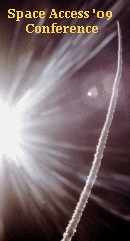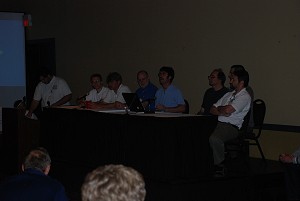|
The primary focus of this conference series has been
on development of low cost space access systems by small
entrepreneurial organizations. While there were no dramatic
announcements at the 2009 meeting, there were many encouraging
signs of steady progress. Not only commercial firms,
but private individuals, student and amateur groups
continue to participate vigorously and to make significant
contributions to the cause.
Here are some of the highlights of the meeting as I
see them:
* The NASA
Ames presentation seemed particularly significant.
NASA's support for science experiments and engineering
applications (e.g. testing instruments intended for
spacecraft) on commercial reusable suborbital space
vehicles appears to be gaining momentum. The first
workshop in December was very well attended and
another
workshop is already scheduled for May. Science and
engineering payloads and attending operators could provide
a significant additional market to space tourism for
companies developing such vehicles and thus bolster
their business plans and help to draw in new investment.
* One downnote was the revelation
by John Carmack that the deal with the Rocket
Racing League to develop suborbital space tourism
vehicles announced
at the NG-LLC event last October had fallen through.
He indicated that new projects along the same lines
are in development, however, and may be unveiled soon.
(Alan Boyle has an update on the RRL: Rocket
racers take it slower - Cosmic Log/msnbc.com - Apr.8.09.)
* There has been no official announcement of new rules
but from hints dropped by several of the Northrop Grumman
Lunar Lander Challenge teams, the competition this year
will not happen at one location on one particular date.
Instead, a team will arrange for a prize attempt at
a place and time of its choosing. The competition window
willl open in July and last till the end of October.
The team that completes the requirements to win a given
level and has the best precision on landing by the end
of the window will win the purse. The second place purse
for Level 1 (two 90 second flights, back and forth between
2 pads) and both first and second place purses for Level
II (180 second flights each direction) remain available
through 2010.
* There were several presentations at the conference
that brought up the subject of the new rules governing
amateur rockets. (Remember: amateur rockets are defined
by the FAA not according to who flies them but according
to the specifications for the rocket and its intended
flight.) While generally they are considered by the
participants at this conference to be a big improvement
over the old rules, there are still complications in
their implementation. Armadillo and Masten, for example,
both experienced lengthy delays in flight tests under
such rules due to problems in obtaining clearance with
FAA air traffic control authorities because they want
to test near the airports where they have their facilities.
* Many groups represented at the meeting are now flying
rocket powered reusable vehicles. Just a few years ago,
only a couple of groups had begun flying such things.
As Henry Vanderbilt indicated, the conference has moved
in stages over the years. Early on the presentations
that got the big applause dealt with plans to
build and fly innovative rocket designs. Then came a
period where a test of a new rocket engine
got the audience excited. Today the audience wants to
see the latest videos of low altitude flights
of reusable rocket vehicles. In upcoming conferences,
the presentations that will get the big applause will
most likely be those showing medium and high altitude
flights.
* XCOR's
Lynx project, which was announced just prior to the
2008 meeting, is moving along just fine (see notes on
Jeff Greason's presentation).
The propulsion system is well in hand and work is proceding
on vehicle structures, aerodynamics, etc. Though no
official schedule has been given out, they look on track
to begin test flights in the second half of 2010.
* Armadillo, as described in John Carmack's presentation,
has become a full-fledged company with permanent employees.
The company actually made money in the past year and
John did not have to put any of his own money into the
organization. He remains ready to do that in the future
if necessary but believes that with additional contracts
and with a successful NG-LLC attempt this year, they
will be self-sustaining without his funding.
* Other projects like Masten Space and Unreasonable
Rocket (Paul Breed) also have definite plans for (unmanned)
medium and high altitude flights. They could begin such
flights this year or next.
* Joint student/commercial firm teams like that with
CSULB/Garvey Spacecraft and SDSU/Flometrics are initiating
lots of innovative rocket technology projects such as
aerospike engines, composite cryogenic fuel tanks, biodiesel
fuels, pistonless pumps, etc. A big problem comes from
mainstream aerospace companies who steal away their
best students but don't support the programs financially.
* N
Prize teams seem to be making serious efforts to
win the competition to launch a tiny payload (19.99
grams) into orbit. Will be interesting to follow their
progress in the coming years.
* Despite the economic downturn, the number of people
attending the meeting was about the same if not a bit
higher than recent SAS meetings. I noticed a number
of "regulars" were missing while a number
of new faces showed up.
|









